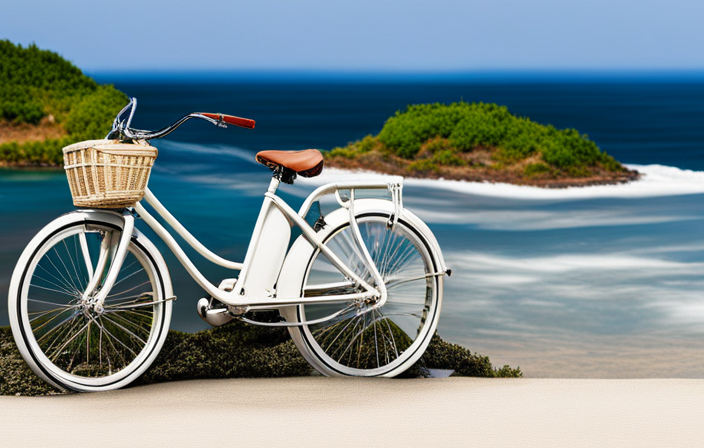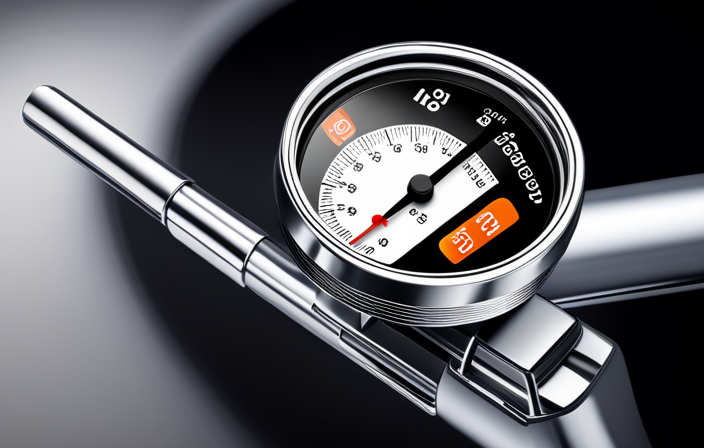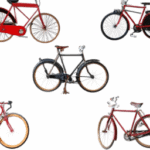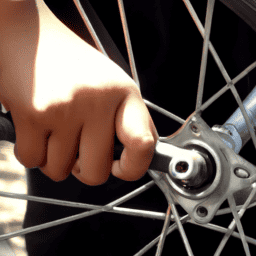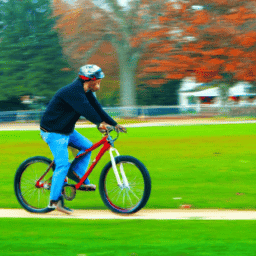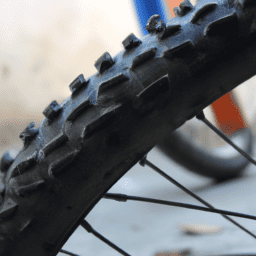The saying goes, ‘a picture is worth a thousand words.’ When it comes to the white bicycle, this single image conveys a deep message.
Originating from a movement rooted in activism and remembrance, the white bicycle has become a powerful symbol in the world of cycling. It represents not only the promotion of sustainable transportation, but also serves as a tribute to fallen cyclists and a sign of solidarity.
In this article, we will explore the history, meaning, and future of the white bicycle movement.
Key Takeaways
- White bicycles raise awareness about the need for safer streets for cyclists and promote cycling advocacy.
- They symbolize shared and sustainable transportation, encouraging the use of eco-friendly modes of transportation and reducing traffic congestion.
- White bicycles represent solidarity and hope, fostering inclusivity and inspiring action towards positive change.
- The white bicycle movement has made a significant global impact, promoting sustainable transportation, healthier lifestyles, and community engagement.
History and Origins of the White Bicycle Movement
So, you’re wondering about the history and origins of the white bicycle movement, huh? Well, let me tell you all about it.
The origins of the white bicycle movement can be traced back to the 1960s in Amsterdam, Netherlands. It was during this time that a group of activists called Provo started placing white bicycles throughout the city for anyone to use.
The significance of these white bicycles was to promote a new concept of urban mobility and to challenge the dominance of cars. The movement quickly gained popularity and spread to other cities around the world.
Today, white bicycles are seen as a symbol of sustainable transportation and community sharing.
With that said, let’s dive into the symbolic meaning of white bicycles and how they have impacted our society.
The Symbolic Meaning of White Bicycles
Imagine a world where a white bicycle holds a symbolic representation and cultural significance. These two-wheeled wonders have become more than just a means of transportation—they have become a powerful symbol of hope, remembrance, and change. The white bicycle movement, born out of a desire to honor fallen cyclists and promote road safety, has spread across cities worldwide. The symbolic meaning of white bicycles is rooted in their purpose: to serve as a tribute to those who have lost their lives while cycling. These bikes, painted entirely white and placed at the site of a cyclist’s death, act as a stark reminder of the fragility of life and the need for safer roads. They also serve as a call to action, urging communities to come together and advocate for better cycling infrastructure. As we delve into the next section about the tribute to fallen cyclists, let us explore the impact these white bicycles have had on our society.
Tribute to Fallen Cyclists
Learn about the tribute to fallen cyclists and how it has impacted our society.
Tribute events and memorial rides are a way for people to honor cyclists who have lost their lives while biking. These events provide a space for grieving families and friends to come together and remember their loved ones. They also serve as a reminder of the dangers that cyclists face on the roads and the need for safer infrastructure.
Tribute events often involve group rides, where participants cycle together in memory of the fallen cyclists. These rides create a sense of community and solidarity among cyclists, and they also raise awareness about the importance of sharing the road and promoting cyclist safety.
By honoring those who have died, these events help to promote a culture of respect and awareness for cyclists. They also serve as a call to action, encouraging individuals and communities to prioritize cycling and sustainable transportation.
Promotion of Cycling and Sustainable Transportation
Get on your bike and start pedaling to promote cycling and sustainable transportation in your community. Here are three reasons why you should join the movement:
-
Health Benefits: Cycling is a great way to stay active and improve your overall fitness. It helps strengthen your muscles, increase cardiovascular endurance, and burn calories. By choosing sustainable transportation like cycling, you not only improve your own health but also contribute to reducing air pollution and traffic congestion.
-
Environmental Impact: Opting for cycling as a mode of transportation helps reduce carbon emissions and lowers your carbon footprint. It is a green alternative to using cars or public transport, which rely heavily on fossil fuels. By promoting cycling, you are taking a step towards a cleaner and greener environment.
-
Economic Savings: Cycling is a cost-effective mode of transportation. By avoiding fuel expenses, parking fees, and public transport fares, you can save money and put it towards other important things. Additionally, promoting cycling can boost local businesses, as cyclists tend to stop more frequently and spend money in the community.
Join the movement for the promotion of cycling and sustainable transportation, and make a positive impact in your community.
Now, let’s delve into the significance of white bicycles as memorials.
White Bicycles as Memorials
Cycling enthusiasts often use white bicycles as memorials to commemorate the lives of cyclists who have lost their lives on the road. This practice of memorialization serves as a somber reminder of the risks cyclists face and aims to raise awareness about road safety.
White bicycles, also known as ghost bikes, are typically placed at the site of a fatal accident, acting as a poignant symbol of remembrance. These memorials not only honor the individuals who tragically lost their lives, but also serve as a call to action for improved infrastructure and cyclist safety measures.
Beyond their practical purpose, white bicycles also hold symbolic value, representing the collective efforts of communities to advocate for safer roads. Transitioning into the subsequent section about white bicycles as art installations, they also serve as powerful visual representations of the importance of cycling as a sustainable mode of transportation.
White Bicycles as Art Installations
Imagine walking through a city and stumbling upon stunning art installations that combine bicycles with intricate designs and vibrant colors. These artistic installations not only serve as eye-catching pieces but also hold cultural significance. They are known as white bicycles, and they have become a popular form of public art in many cities around the world.
To understand the impact of white bicycles as art installations, let’s take a look at the following table:
| City | Artist | Cultural Significance |
|---|---|---|
| Amsterdam | Krijn de Koning | Promotes cycling as a sustainable mode of transportation |
| New York City | Ai Weiwei | Represents freedom and individuality |
| Berlin | Ai Weiwei | Symbolizes resistance against oppressive regimes |
| Tokyo | Yayoi Kusama | Reflects the city’s bustling energy and vibrant culture |
These installations not only beautify the urban landscape but also provoke thought and conversation. Transitioning into the subsequent section about white bicycles as community initiatives, these art installations inspire individuals to come together and create meaningful change.
White Bicycles as Community Initiatives
You can appreciate the impact of white bicycles as community initiatives by considering their role in fostering collaboration and empowerment among individuals.
These initiatives aim to promote community engagement and improve urban planning by providing free bicycles for public use. White bicycles are often placed strategically in urban areas, inviting residents and visitors to take a bike and explore the city. By encouraging alternative modes of transportation, these initiatives reduce traffic congestion and promote a healthier lifestyle.
Moreover, white bicycles serve as a symbol of unity and shared responsibility, as they rely on the collective effort of the community to maintain and respect the bikes. This sense of ownership and collaboration strengthens social ties and empowers individuals to actively participate in shaping their community.
Transitioning into the next section, white bicycles not only foster community engagement but also serve as a call for safer streets.
White Bicycles as a Call for Safer Streets
As we have previously discussed, white bicycles have been used as community initiatives to provide free transportation for everyone. However, they also serve another important purpose: advocating for safer streets.
The white bicycles act as a visual reminder of the need for improved cycling infrastructure and increased safety measures. Bicycle activism plays a crucial role in this movement, with individuals and organizations working tirelessly to promote cycling as a sustainable and safe mode of transportation.
By strategically placing white bicycles in public spaces, activists aim to raise awareness about the importance of creating bike-friendly streets and reducing the risks that cyclists face daily. These efforts not only benefit cyclists but also contribute to building healthier and more environmentally-friendly communities.
With that in mind, let’s explore how white bicycles serve as a reminder of cycling advocacy and its impact on society.
White Bicycles as a Reminder of Cycling Advocacy
Explore how white bicycles serve as a visual reminder and symbol of the ongoing efforts in advocating for safer streets and promoting cycling as a sustainable mode of transportation.
White bicycles, also known as ghost bikes, are strategically placed in public spaces to draw attention to the importance of cycling advocacy. They serve as a poignant reminder of the need for safer streets, where cyclists can feel protected and respected. These ghost bikes evoke a range of emotions, including sorrow for lives lost, anger at the lack of infrastructure, and determination to create change.
Cycling advocacy is crucial for several reasons. It promotes physical health, reduces traffic congestion, and decreases air pollution. By advocating for cycling, we can create a safer and more sustainable environment for everyone.
Transitioning into the subsequent section about ‘white bicycles as a statement against car dominance,’ we can further explore the impact of these symbols on our society.
White Bicycles as a Statement Against Car Dominance
Placing white bicycles in public spaces serves as a powerful statement against the dominance of cars in our society. It symbolizes a shift towards community engagement and a reevaluation of urban planning. By providing free bicycles for public use, white bicycles encourage people to choose alternative modes of transportation and reduce their dependence on cars. This small act of placing white bicycles in public spaces not only promotes a healthier and more sustainable lifestyle, but also challenges the car-centric culture that prevails in many cities. It sends a message that our streets should be designed to prioritize the needs of pedestrians and cyclists, rather than solely catering to cars. White bicycles serve as a reminder that we can create more livable and inclusive cities by embracing shared transportation options. This transition towards a more balanced transportation system is crucial for the well-being of our communities.
White Bicycles as a Sign of Shared Transportation
Using a white bicycle in public spaces can be seen as a symbol of embracing and participating in a shared transportation system. White bicycles have become a prominent feature in many cities around the world, representing community initiatives aimed at promoting sustainable transportation and reducing car dominance.
These bicycles are often available for anyone to use, free of charge, encouraging people to leave their cars at home and opt for a more eco-friendly mode of transportation. By utilizing these white bicycles, individuals not only contribute to reducing traffic congestion and air pollution but also foster a sense of community and shared responsibility for the environment.
This symbol of shared transportation serves as a reminder that we can all play a part in creating a more sustainable future. Transitioning into the subsequent section about ‘white bicycles as a sign of solidarity,’ these bicycles also represent a collective effort towards a common goal.
White Bicycles as a Sign of Solidarity
When you see a white bicycle in public spaces, it signifies a sense of unity and support for a common cause. The presence of these white bicycles is often associated with the solidarity movement and community support. Here are four key aspects to consider:
-
Symbol of shared values: White bicycles represent a collective commitment to promoting a better community and advocating for change.
-
Sense of belonging: The sight of a white bicycle can foster a feeling of inclusivity and togetherness among individuals who share similar goals.
-
Visual reminder: These bicycles serve as a visual reminder of the ongoing efforts to create a more equitable and supportive society.
-
Encourages action: The presence of white bicycles can inspire individuals to take action and contribute to the cause they represent.
With their powerful symbolism, white bicycles transcend mere objects and become a form of activism, promoting positive change and social progress.
White Bicycles as a Form of Activism
You can understand the significance of white bicycles as a form of activism by recognizing their ability to inspire and mobilize individuals towards positive social change.
Activism through bicycles has gained momentum as people realize the power of cycling to raise awareness and advocate for various causes. By taking to the streets on their bikes, activists are able to reach a wider audience and create a visible presence in their communities.
Whether it’s advocating for environmental sustainability, promoting bike safety, or fighting for social justice, white bicycles serve as a symbol of activism and a tool for change. They remind us of the power of collective action and the impact that individuals can have when they come together for a common cause.
White bicycles are not just a means of transportation; they are a form of expression, a call to action, and a catalyst for positive social change. With each pedal stroke, we are reminded of the possibilities for a better future.
White Bicycles as a Symbol of Hope and Change
Cycling enthusiasts have embraced white bicycles as a powerful symbol of hope and change. These bicycles, painted entirely white and placed in public spaces, have had a significant impact and influence on communities around the world. Here are four reasons why white bicycles evoke such strong emotions:
-
Remembrance: White bicycles serve as a poignant reminder of lives lost due to traffic accidents, encouraging us to strive for safer streets.
-
Equality: By making bicycles freely available to everyone, regardless of socio-economic status, white bicycles promote a sense of fairness and inclusivity.
-
Environmentalism: White bicycles symbolize a shift towards sustainable transportation, inspiring individuals to choose cycling over cars and reduce their carbon footprint.
-
Activism: The presence of white bicycles sparks conversations about the importance of cycling infrastructure and the need for policy changes.
As we look towards the future of the white bicycle movement, it is clear that this symbol will continue to drive positive change in our communities.
The Future of the White Bicycle Movement
If you embrace the future of the white bicycle movement, it will continue to drive positive change in our communities. The white bicycle movement has already made a significant impact globally, and future initiatives will only amplify its reach. By providing free bicycles for public use, this movement promotes sustainable transportation and encourages individuals to adopt healthier and more eco-friendly lifestyles. Additionally, the white bicycle symbolizes hope and unity, reminding us that we are all part of a larger community. Looking ahead, there are several exciting possibilities for the future of this movement. For example, implementing bike-sharing programs in major cities could further reduce traffic congestion and carbon emissions. Furthermore, expanding the movement to underserved areas and developing countries would provide access to transportation for those in need. By continuing to support and invest in the white bicycle movement, we can create a lasting global impact and foster a more sustainable future for all.
| Pros | Cons |
|---|---|
| Promotes sustainable transportation | Potential theft or vandalism |
| Encourages healthier lifestyles | Limited availability in some areas |
| Symbolizes hope and unity | Lack of funding for expansion |
| Reduces traffic congestion and carbon emissions | Maintenance and repair costs |
Frequently Asked Questions
How can individuals participate in the White Bicycle Movement and contribute to the cause?
To participate in the white bicycle movement and contribute to the cause, I can start by spreading awareness about the initiative, organizing group rides, volunteering at bike-sharing programs, and supporting organizations that promote cycling infrastructure. Impact can be measured through increased bike usage and reduced carbon emissions.
Are there any specific guidelines or regulations for placing white bicycles as memorials or art installations?
There are guidelines and regulations for placing white bicycles as memorials or art installations. For example, in some cities, permission must be obtained from local authorities, and the bicycles must be securely installed to ensure public safety.
What are some examples of successful community initiatives involving white bicycles?
Successful community initiatives involving white bicycles include programs like Ghost Bikes, which honor fallen cyclists, and bike-sharing programs that promote sustainable transportation. These initiatives use white bicycles as a symbol of remembrance or as a means of promoting cycling in communities.
How can white bicycles be used to promote safer streets and advocate for cycling rights?
Promoting cycling safety and advocating for cycling rights can be achieved through the use of white bicycles. These bicycles serve as a visual reminder of the importance of cycling, encouraging safer streets and raising awareness for cyclists’ rights.
What are some potential challenges or obstacles that the White Bicycle Movement may face in the future?
Some challenges and obstacles that the white bicycle movement may face in the future include resistance from car-centric cultures, lack of funding for maintenance and expansion, and potential vandalism or theft of the bicycles.
Conclusion
In conclusion, the white bicycle movement holds a powerful message and serves as a reminder of the importance of cycling and sustainable transportation.
These bicycles symbolize more than just a mode of transportation; they represent solidarity, activism, and hope for a better future.
As we continue to advocate for safer roads and promote cycling, the white bicycles will remain as memorials and symbols of change.
Let us pedal forward together, united in our mission for a greener and more sustainable world.
